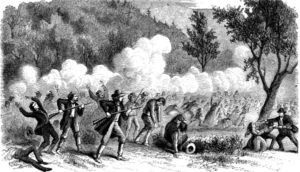1857 The Mountain Meadows Massacre
The USA in the 19th century was fertile ground for the propagation of startling new religions: the Shakers, the Seventh-Day Adventists, Millerites, Jehovah’s Witnesses, and Christian Scientists. None aroused as much opposition or violence as the Church of Jesus Christ of Latter Day Saints, the “Mormons”. Founded by Joseph Smith in New York in the 1830, the sect was regarded with great suspicion for its new revelations, causing the church to gradually move west to find safe ground. In 1844 the church’s founder, Joseph Smith, and his brother were murdered by a mob and tensions increased to the point that its adherents abandoned their work in Missouri and Illinois and determined to establish a new Zion on the Utah plains. Led by Brigham Young, the church establish a colony and several cities around the Great Salt Lake. Young’s theocracy and scandalous rumours caused the American government to send the army against the Mormons in 1857.
It was at this moment when a wagon party of west-bound emigrants from Arkansas, known as the Baker-Fancher Train, entered Mormon territory. There they found the inhabitants hostile and stirred up by preachers spreading ideas of resistance to American forces and violence against outsiders. Talk of the End Times and God’s final acts of vengeance were in the air. Unable to buy the supplies they needed in Salt Lake City, the wagon party headed south. When they were camped at Mountain Meadows they were attacked by local Mormons disguised as Paiutes and some local tribesmen. After a siege of seven days, the settlers were promised safe conduct if they would surrender their animals and supplies to the natives but when they came out from behind their fort of wagons they were set upon and massacred. Every adult and child above the age of seven were killed, 120 in all, and seventeen infants were taken and given to Mormon families. The bodies were left unburied and the settlers’ property was divided among the Paiutes and Mormons.
The arrival of the American army prompted an investigation of the murders which was hindered by the Mormons. It has never been established whether Brigham Young had given the order for the killings but he did nothing to punish the perpetrators. Only one man was ever brought to justice twenty years later. The site of the massacre is now a National Historic Landmark.
